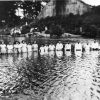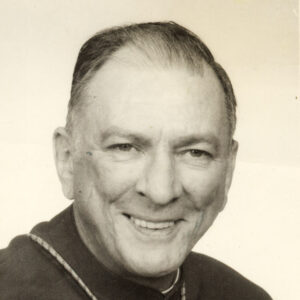calsfoundation@cals.org
Lawrence Preston Graves (1916–1994)
Lawrence Preston Graves served as the second auxiliary Roman Catholic bishop for the Diocese of Little Rock, which encompasses the state of Arkansas. Graves was also the second native Arkansan to be elevated to the Catholic hierarchy.
Lawrence Graves was born on May 4, 1916, in Texarkana (Miller County); his parents, Louis Graves and Agnes Fant Graves, were local grocers. They had two sons and two daughters. Raised in St. Edward’s Church in his hometown, he attended all twelve grades in the local parish school and was a member of the first graduating high school class. At eighteen, Graves entered St. John’s Seminary in Little Rock (Pulaski County) and, two years later, Bishop John B. Morris sent him to the North American College in Rome, Italy. When Italy entered World War II in June 1940, Morris re-called him to St. John’s. On June 11, 1942, Bishop Morris ordained him as a Catholic priest.
After a year at Immaculate Conception Church in Fort Smith (Sebastian County), Graves was transferred to the Little Rock Seminary to teach moral theology. In 1945, Morris dispatched Graves to the Catholic University of America to earn a licentiate in canon law. Upon returning to Arkansas in 1947, Graves was appointed by newly installed Bishop Albert L. Fletcher as vice chancellor for the diocese. Bishop Fletcher assigned him to the seminary to teach in early 1948. By 1961, Graves became a full-time assistant to Bishop Fletcher with the designation monsignor. (Monsignor is an honorary title given to a diocese priest by the pope upon the recommendation of the local bishop.)
Pope John XXIII convened the Second Vatican Council (commonly called Vatican II) in Rome, which met in four sessions during the autumns of 1962–1965. Bishop Fletcher attended, and Msgr. Graves served as his aide, theologian, and translator. Fletcher acknowledged in his “Reminiscences” that he relied greatly on Graves, whose Latin and Italian language skills were far better than his.
When Fletcher turned seventy in 1966, he petitioned the new Pope Paul VI to give him an auxiliary bishop; Fletcher’s predecessor, Bishop Morris, had done the same thing decades earlier. On February 24, 1969, word arrived from Rome that Graves was to become auxiliary bishop, the second native Arkansan in the Catholic hierarchy. As the Little Rock diocese then belonged to the ecclesiastical province of New Orleans, Louisiana, Archbishop Philip M. Hannan presided over the ceremony. With thirty other prelates present, Graves was consecrated bishop at St. Andrew’s Cathedral. On April 25, 1969, exactly twenty-nine years from the day Fletcher became auxiliary bishop.
In having Graves named his auxiliary bishop, Fletcher probably hoped that this might influence Rome regarding his successor; after all, he had been an auxiliary bishop under Morris and had succeeded him. Yet history did not repeat itself. After Vatican II, Pope Paul VI required all bishops to submit their resignations after reaching seventy-five years of age. Fletcher celebrated that milestone in late October 1971 and thus submitted his resignation the following January. U.S. Apostolic Delegate Archbishop Luigi Raimondi told Fletcher not to announce his retirement until his successor was chosen.
Little Rock’s next bishop, however, would be from Georgia, not Arkansas. Msgr. Andrew J. McDonald of Savannah was informed on June 11, 1972, that he was to be the fifth Arkansas Catholic bishop. Bishop McDonald arrived to take up his duties on September 7, 1972. This presented an awkward situation for Auxiliary Bishop Graves. Normally, an auxiliary assists an aging or infirm prelate. Not yet fifty, Bishop McDonald certainly did not need an assistant. A month after McDonald’s installation, the pope reappointed Graves as auxiliary bishop on October 7, 1972.
In December 1972, Graves became pastor at St. Joseph’s Catholic Church in Pine Bluff (Jefferson County). Graves was soon embroiled in a difficult problem involving the merger of two Catholic schools, one for white students and one for African-American students. While he was still dealing with this situation, documents arrived from Rome dated May 10, 1973, stating that Graves was to be the seventh bishop of Alexandria, Louisiana. On September 18,1973, Graves was installed at the St. Francis Xavier Cathedral in his see city, with Archbishop Hannan serving again as the presiding prelate. He was joined by retiring Alexandria prelate Charles P. Greco and bishop emeritus Fletcher. At that time, this Louisiana diocese was 120 years old and occupied the northern half of the state. Due to ill health, Bishop Graves retired from his Louisiana see on July 20, 1982. He continued to live in Alexandria until his death on January 15, 1994. His grave is in Maryhill Seminary Cemetery near Alexandria.
For additional information:
Archives of the Diocese of Little Rock. St. John’s Catholic Center, Little Rock, Arkansas.
“Bishop Lawrence Preston Joseph Graves.” Catholic-Hierarchy.org. http://www.catholic-hierarchy.org/bishop/bgraves.html (accessed September 15, 2020).
“Catholic Bishop Dies.” Arkansas Democrat-Gazette, January 16, 1994, p. 7B.
Parker, Suzi. “Humbleness, Humor Displayed by Priest.” Arkansas Democrat-Gazette, January 17, 1994, p. 4B.
Woods, James. Mission and Memory: A History of the Catholic Church in Arkansas. Little Rock: August House, 1993.
James M. Woods
Georgia Southern University
 Divergent Prosperity and the Arc of Reform, 1968–2022
Divergent Prosperity and the Arc of Reform, 1968–2022 Religion
Religion Lawrence Preston Graves
Lawrence Preston Graves 




Comments
No comments on this entry yet.